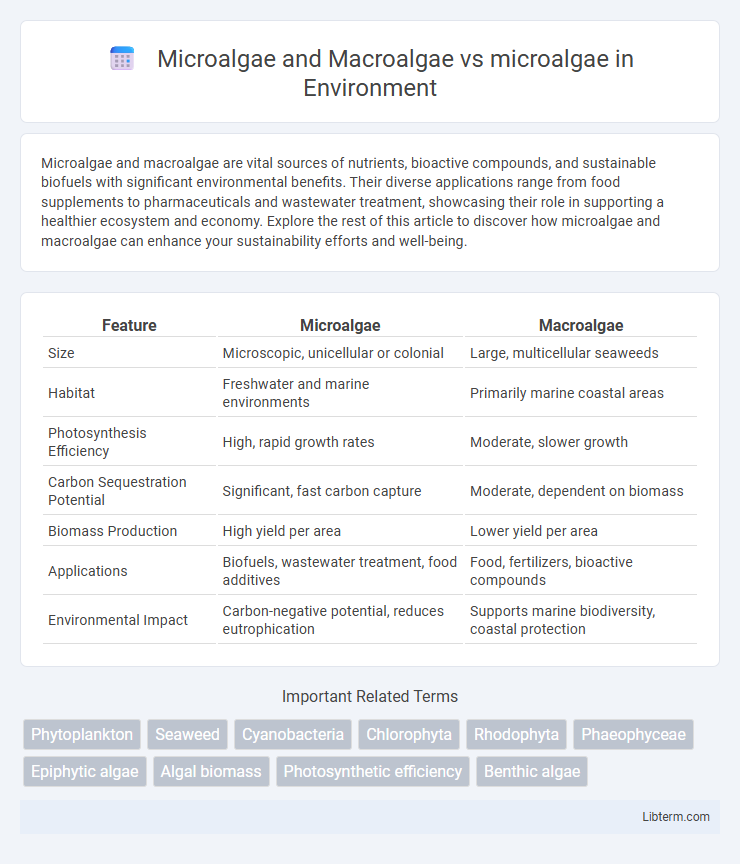Microalgae and macroalgae are vital sources of nutrients, bioactive compounds, and sustainable biofuels with significant environmental benefits. Their diverse applications range from food supplements to pharmaceuticals and wastewater treatment, showcasing their role in supporting a healthier ecosystem and economy. Explore the rest of this article to discover how microalgae and macroalgae can enhance your sustainability efforts and well-being.
Table of Comparison
| Feature | Microalgae | Macroalgae |
|---|---|---|
| Size | Microscopic, unicellular or colonial | Large, multicellular seaweeds |
| Habitat | Freshwater and marine environments | Primarily marine coastal areas |
| Photosynthesis Efficiency | High, rapid growth rates | Moderate, slower growth |
| Carbon Sequestration Potential | Significant, fast carbon capture | Moderate, dependent on biomass |
| Biomass Production | High yield per area | Lower yield per area |
| Applications | Biofuels, wastewater treatment, food additives | Food, fertilizers, bioactive compounds |
| Environmental Impact | Carbon-negative potential, reduces eutrophication | Supports marine biodiversity, coastal protection |
Introduction to Algae: Microalgae vs. Macroalgae
Microalgae are microscopic, single-celled organisms found primarily in aquatic environments, playing a crucial role in carbon fixation and oxygen production. Macroalgae, commonly known as seaweeds, are multicellular and larger, contributing significantly to coastal ecosystems and serving as important resources in food, pharmaceuticals, and biofuel industries. Both microalgae and macroalgae exhibit diverse species adapted to various environmental conditions, but microalgae have higher growth rates and biochemical productivity, making them valuable for biotechnological applications.
Defining Microalgae: Characteristics and Types
Microalgae are microscopic, single-celled algae found in freshwater and marine environments, characterized by their ability to perform photosynthesis and rapid growth rates. Unlike macroalgae, which are multicellular and visible to the naked eye, microalgae include diverse groups such as diatoms, green algae, and cyanobacteria, each with unique pigments and cellular structures. These organisms play a crucial role in carbon fixation, biofuel production, and as nutritional supplements due to their high protein, lipid, and antioxidant content.
Understanding Macroalgae: Features and Classification
Macroalgae, also known as seaweeds, are large, multicellular algae classified into three major groups: brown algae (Phaeophyceae), red algae (Rhodophyta), and green algae (Chlorophyta). These organisms possess differentiated structures such as holdfasts, stipes, and blades, which distinguish them from microscopic, unicellular microalgae. Macroalgae play crucial ecological roles in marine environments, providing habitat, food, and contributing to carbon fixation through photosynthesis.
Key Differences Between Microalgae and Macroalgae
Microalgae are microscopic, unicellular organisms found primarily in aquatic environments, while macroalgae are large, multicellular seaweeds visible to the naked eye. Microalgae reproduce rapidly through cell division and are rich in proteins, lipids, and pigments, making them valuable for biofuel and nutraceutical industries. Macroalgae, such as kelp and sea lettuce, have complex structures and are commonly used in food, agriculture, and pharmaceuticals due to their high fiber and mineral content.
Ecological Roles: Microalgae and Macroalgae in Aquatic Environments
Microalgae and macroalgae play critical ecological roles in aquatic environments by supporting primary production and nutrient cycling. Microalgae contribute significantly to oxygen generation and form the base of aquatic food webs, sustaining a wide range of marine species. Macroalgae, such as kelp forests and large seaweeds, provide essential habitats and shelter, enhancing biodiversity and stabilizing coastal ecosystems.
Industrial Applications: Microalgae vs. Macroalgae
Microalgae exhibit rapid growth rates and high lipid content, making them ideal for biofuel production, pharmaceuticals, and nutraceuticals, while macroalgae offer robust biomass yield suitable for food additives, fertilizers, and bioplastics. Industrial-scale cultivation of microalgae relies on photobioreactors and open ponds to optimize CO2 fixation and lipid extraction, contrasting with macroalgae's seaweed farming in marine environments that supports sustainable harvesting for agar, alginate, and carrageenan. The biochemical versatility of microalgae enables production of omega-3 fatty acids and pigments, whereas macroalgae's polysaccharides and minerals drive applications in the cosmetics and agriculture sectors.
Nutritional Value Comparison: Microalgae vs. Macroalgae
Microalgae contain higher concentrations of essential proteins, omega-3 fatty acids, vitamins (such as B12), and antioxidants compared to macroalgae, making them a dense nutritional source. Macroalgae, while lower in protein, provide significant amounts of dietary fiber, iodine, and minerals like calcium and iron, which support thyroid health and digestion. The bioavailability of nutrients in microalgae is generally superior, enhancing their effectiveness in human nutrition compared to many macroalgae species.
Challenges in Cultivating Microalgae and Macroalgae
Microalgae cultivation faces challenges such as maintaining optimal light, temperature, and nutrient levels in controlled environments to ensure high growth rates and biomass yield. Macroalgae farming struggles with environmental variables like wave action, salinity fluctuations, and nutrient availability, which can limit productivity and increase operational costs. Both microalgae and macroalgae require advanced monitoring and harvesting technologies to overcome contamination risks and improve scalability for commercial applications.
Sustainability and Environmental Impact
Microalgae and macroalgae both offer sustainable solutions for biofuel production and carbon sequestration, but microalgae present higher efficiency in biomass yield and faster growth rates, enabling more effective carbon capture. Macroalgae cultivation requires coastal space and can impact marine ecosystems, whereas microalgae can be cultivated in controlled bioreactors, reducing habitat disruption and freshwater use. The environmental impact of microalgae is minimized by utilizing wastewater and CO2 emissions, promoting circular economy practices in bioenergy and bioproducts.
Future Prospects and Innovations in Algae Utilization
Microalgae and macroalgae show significant potential for future innovations in sustainable biofuel production, bioremediation, and high-value nutraceuticals, driven by advancements in genetic engineering and bioprocess optimization. Emerging technologies focus on enhancing lipid accumulation in microalgae and improving macroalgae cultivation systems to support carbon sequestration and biodegradable materials. Integration of algae-based solutions with circular economy models is expected to revolutionize environmental sustainability and industrial applications by 2030.
Microalgae and Macroalgae Infographic

 libterm.com
libterm.com